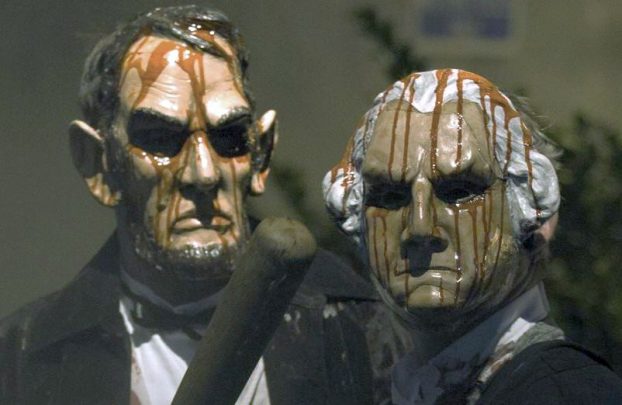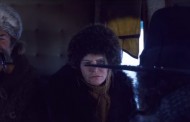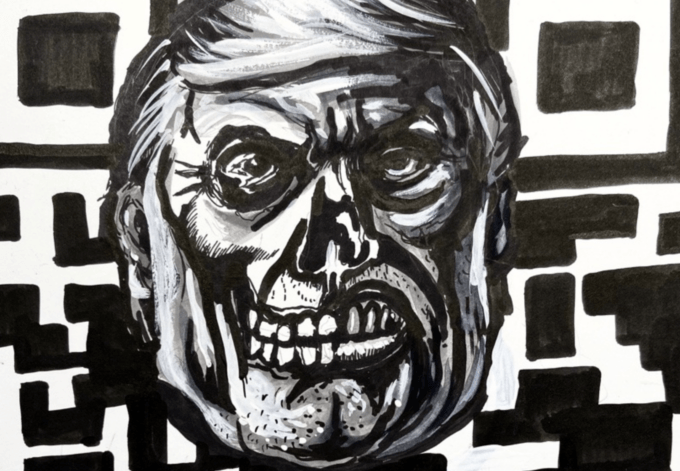
The Purge: Election Year. Photo courtesy of Universal Pictures.
Published on http://www.brightlightsfilm.com/
I attended a matinee on discount Tuesday at a local mall theatre but instead of the usual retirees, there was less than ten millennials. The previews, which key you to how the audience for the feature film is profiled, were all for slasher/bloody/Halloween/scary things happen in the dark movies.
I was not there for the blood but because of this note from a friend about his viewing of the film:
Just saw the Purge, in a Bangkok movie theater. After the 30 minutes of previews and a request to stand and solute the king during his “anthem,” I was treated to an accidental postmodern critique on our current political situation. Not quite fascinating, or as good as Fight Club, but interesting. I’d be curious to hear your thoughts.
The where and when of viewing matters, regardless of the fact that we go to the movies to be entertained, and mostly to forget the where and when of our lives. But we cannot escape bringing the baggage of our own experiences into the theatre. I’m not sure how the “everyday Thai” feels about the U.S., but as Thai Budhists have been murdered by Thai Muslims only because they are kafir, not Muslim, I reckon that purge is familiar to that audience. Here among my own American audience I have a feeling that a depiction of a dystopic America is something “everyday Americans” are becoming familiar with in this 2016 Presidential season.
Which “everyday Americans”? More likely “disaffected” wage earners and not gentrifying dividend receivers see a future of purging the poor as dystopia and not a path to utopia. But right now the future is wrapped up in Donald Trump’s promise to make America great again, a promise that seems to be appealing to both the winners and the losers. They, however, differ as to what draws them, like a magnet.

A Donald Trump for President campaign yard sign in West Des Moines, Iowa. Photo by Tony Webster. Reprinted with permission through Wikimedia Commons.
Those scheduled for a variety of reasons to become increasingly more removed from former middle-class glories and thus more disaffected see Trump as making things better for them. Although Bernie Sanders tried to outline a path to making things better for them by targeting the oligarchs, he clearly failed because the disaffecteds’ savior is Trump, an oligarch narcissist with roots in privilege and bounty.
Those scheduled by their stock portfolio, inherited wealth, and corporate bonuses in the process of establishing domains of fiefdom where democracy once stood see Trump as a law-and-order defender of the wealth order they enjoy. Miraculously, Trump will purge on their behalf the threat of a mounting anger and frustration among some 80% of the American population whose disaffection threatens at the gates of every rich man’s compound.

Donald Trump after signing the pledge of allegiance, Sept. 3, 2015. Photo by Michael Vadon. Reprinted with permission through Wikimedia Commons.
Think of President Trump as the Great Purger protecting a fearful plutocracy as well as the Great Savior of all wage earners, working and middle class, who have been rushed to an economic bottom from which they believe Trump will rescue them. There is certainly reason to see strength in a candidate whose appeal crosses the Grand Canyon divide that now exists in the U.S. between creditors and debtors, winners and losers, the gentrifiers and the foreclosed.
So there we have the current American “where and when” of this third dramatization of purging, which simply accelerates the contraction of all the opposing intensities we are experiencing in off-screen reality. And proposes a simple, efficient remedy: one side will purge the other.
The wealth class’s fears have reached the point that a purging of the poor, before they reach a political awareness, is good plutocratic policy. And the poor have reached the point of engaging in a guerrilla warfare in defense. In the middle, we have the hope of a democratic electoral politics restraining the power of the wealthy and recuperating the lives of those who have been targeted for extinction. This mirrors well a present loss of faith in electoral politics, as well as a hope, in a woman in both real and reel politics, that a popular will can enact a politics that benefits them and not the plutocrats. In our real world surround, however, a truly populist will is, ironically, in support of the rich man, Trump. Our real-world surround thusly has not the clear moral divide of the movie but instead clouds both our grasp of the threat as well as its remedy. This mass-market, popular film will clarify and resolve in a manner that our real world always denies us.

Frank Grillo as Leo Barnes. Photo courtesy of Universal Pictures.
This does not mean that the film is soothing. The setting of the film is unsettling, to say the least, and in an equally unsettling way. What we have is a movie that plunges into the increasing madness firing up in a society losing hold of any bonds of commonality. It pushes that fracturing to full dystopia, in-your-face pandemonium, plays all the rancor and antagonism to an nth degree. The whole world is peaking on bloody shootings and massacres as hatreds and fears have seemed to heat up along with 2016 being the hottest year on record. Hate is not difficult to kindle in those who have been left out of the dividend profits of globalization this last quarter century, while fear of the disaffected has pushed plutocrats to a “by any means necessary” defense.
It becomes clear at once that whatever thematic impact it may have, such as “anti-violence” (read “anti-gun”) or “the rich make victims of the poor,” this is a movie that cleverly tacks its way in the turbulent waters of the U.S. at this moment. And it does so in a sea of blood not only because we seem clearly to be heading for more mad sprees of bloodletting in the U.S. but also because murder and mayhem is an attracting popular genre.
In the U.S., this fear has led to the dirty politics of a coded racism, bigotry, misogyny, and xenophobia, which the Republican candidate for president, Donald J. Trump has boldly played openly without any censure or reprimand sticking to him. Perennially caught on the bottom of the economic well-being scale, blacks in the U.S. now face expulsion by gentrification, which once again puts them in the gun sights of a policing respectful of a gentrifying order, where money and power join, and disrespectful of those who continue to remain powerless and impoverished, regardless of a token representation of blacks in every power sector.
Senator Charlie Roan, played by a tall Aryan blonde whose senatorial creds are displayed by large, black-frame eyeglasses, is a presidential candidate who grates and infuriates the ruling order, the NFFA (New Founding Fathers of America), by defending the poor the NFFA wish to exterminate. We seesaw between former senator Hillary Clinton or present senator Elizabeth Warren here as a real-world Roan and in doing so touch a hot spot of undecidability in Hillary’s candidacy: Is she too much in league with the fat cats, with Wall Street, the NFFA? And does Warren remain on the outside of this election because she’s so far to the left of the median American position regarding the wealth divide that she can’t rise to be a Charlie Roan contending for the presidency?

Elizabeth Mitchell as Charlie Roan. Photo courtesy of Universal Pictures.
This “median American position” in regard to race, the wealth gap, guns and murder, the poor, politics, and power does not exist in any way that the film can represent. All it can do is steer between realities that only exist in extremes. There cannot be a cinematic equivalent to a “No Labels” politics because there would be no action, no drama, and no oppositions to portray. The popular intent of a popular film is to clear the ambiguous moral middle and present unambiguously good versus evil.
Nevertheless, the uncertainties and confusions of a real-world surround trouble our viewing. Donald Trump’s successes have made him the Republican nominee for the presidency. They are successes built upon hatred and fear. If you extend that hatred and fear into a future in which walls and prisons are replaced with a purging of everyone we hate and fear, we have The Purge: Election Year. If the film made this extrapolation clear, it would be polemical, not popular, and yet that connection remains, like an objection overruled in court but remaining in the minds of the jury.
“Black Lives Matter” enough to have sealed the fate of Bernie Sanders’s campaign at the get-go. Bernie had put economics before race, but headline events made racism observable on YouTube while the politics and economics of plutocracy required tutorials Americans were not going to sit for. Race still matters more to those who witness racist acts than does the scary matter of wealth redistribution. At the very moment it seemed a consensus of outrage was being reached over the police shootings of blacks, Donald Trump successfully stirred up a white rage against a Black Lives Matter movement on the rise. He has stirred up anger at Mexicans, who are, in his view, mostly criminals storming across the border, taking American jobs, and suckling at the liberal welfare teat.

November 15, 2015, protest of the police shooting of Jamar Clark in Minneapolis. Photo by Fibonacci Blue. Reprinted with permission through Wikimedia Commons.
Once again, the film cannot dramatize a middle-ground solution, which has no presence either in the film or in the world, and would confuse and trouble moral determinations. The dramatic tension is in the ful-hearted display of anger and hatred. A cathartic purging is a good alibi for the bloodbath, as is a thread of friendship, loyalty, and altruism, which in the end enables an audience to escape the Purge and any involvement with a purge, now or in the future. In short, blood runs over and conceals all the uncertainties and dilemmas we face in a real world of politics gone amok. Or tries to.
Consider the character Joe Dixon, a small-business owner, a man who started his own business instead of going on welfare. He is therefore a man who will be harmed if taxes and minimum salary levels are raised. Government in the neoliberal view is not a friend to the small-business owner. Then the swing to the other side as Joe receives word that his insurance has gone up for Purge night and it is more than he can afford to pay. This is a private-sector holdup. One wonders how Joe pays for his health care. Has the government come to his aid?
We also learn that he has been a mentor to Lanny Rucker, one time called “Little Death,” who is now risking her life driving to save people on Purge night. Joe has also been a father figure to Marcos, a young man from Mexico, who stands loyally by Joe. Is Marcos representative of the Mexicans who bring “drugs, crime and are rapists” into the country, or is he one of the good people that Trump assumes exist? The black school girls from Hell, who return to Joe’s Deli to kill him, force us to draw back from thinking that all blacks under the gun by the New Founding Fathers of America are innocent victims of white tyranny. Blacks here want to purge blacks. The leader of the Black anti-Purge group, Dante Bishop, wants to purge the NFFA, who want to purge Dante’s anti-Purge group. Think of ending rape by raping the rapists, or stopping theft by robbing the thief.

Dante Bishop (Edwin Hodge) and Leo Barnes
In all these situations, we are left on the horns of a dilemma that rocks the present gun control debate that emerges every time a crazy decides to purge the innocent. Is the best way to protect yourself to arm yourself? If Senator Roan becomes president, she says she will ban the Purge by executive order. No need, she tells Dante, to purge the purgers. An executive act will stop the purging of the poor, but what about the cleansing of aggression, the alibi presented for a purge? Do we need guns because all forms of insane aggression surround us and the police are themselves targets and not protectors? Do we need guns because we humans are always in a constant state of purging each other?
We rush past two women who are in some state of emotional catharsis after killing their husbands/lovers. The street gangs seem to be carrying on their battles whatever the night may be. Natural-born killers purge each other, not needing a legalized hunting night. In short, how can a film bathed in bloody violence envision for us some gun-less, peaceful society? Joe is a two-gun shooter, Marcos is a sharpshooter, and Lanny blows heads off with a shotgun with a steely look in her eye like a female John Wayne at a shootout. Even the senator is given a gun, which she may carry into the White House with her.

“Keep America Great.” Courtesy of University Pictures.
We can stop an open season on the poor, but can we purge the violence out of a nation born in genocide and slavery, a nation that continues to use violence, behind the mask of diplomacy, to keep the world in check?
We face the peculiar situation where a culture bred on gun violence cannot recognize it as apart from who they are, rather like the way smokers cannot envision life without cigarettes. It is difficult to either overwhelm a populace with violence or turn them away from it if it is part of their cultural milieu. Think of Native American tribes in the past leaving the old behind to die, or the Japanese tradition of hara-kiri, or the meme that declares “To be is to consume.”

Illustration of a scene of hara-kiri in the Japanese theater, made by Kubota Seiko for the American magazine Outing in 1894. Public domain image obtained through Wikimedia Commons.
Violence in the U.S. is so much a part of things that it can be entertaining. Witness our video games where displays of gun violence are most profitable. We gravitate toward a long-standing expression of our natures. “The fault,” Ethan Gach writes, “lies not in our stars, or even our politicians, but in ourselves. Just look at the best-selling games of 2012. The list demonstrates an unsettling duality. We like to dance and sing in video games and throw a digital pigskin around. But we also love shooting to kill” (venturbeat.com, Jan. 16, 2013).
To be a popular film, which is the intent of the Purge series, is to play into what an audience loves; and in the case of something it is not supposed to love, namely bloody, indiscriminate violence, some facade of censure and recuperation must be present. At the same time, the film cannot be labeled as anti-gun or as opposed to the idea of the necessity of violence upon occasion. Americans have the right “to stand your ground” at home and bomb the hell out of terrorists in their homes. There is a political correctness that gags our natural bloody instincts in the same way it gags our speech. Bloodletting on the screen is an escape from that imprisonment. It’s an instinctual, bestial, dehumanized passion that remains the perennial favorite frontier of profit making.
The Purge: Election Day Year chooses to stand its redemptive ground, the masking of the bloodletting, on the idea that the government should not be killing poor people. The film is betting consensus on this. Neutral about guns and violence but partisan about killing poor people. This seems safe, but then again in a society bursting out in class, race, religion, gender and ethnicity warfare, it is difficult to find safe, neutral territory. Poverty and the poor cannot be left uncriticized. There is a neoliberal beef against the poor: they wouldn’t be poor if they worked hard and had the ambition to fulfill the American Dream of starting a business. They become “moochers” who don’t vote and don’t contribute anything at all to the common good. Poverty is what happens when people lose the “will to win.” The poor must be held responsible for their own immiseration. The film does not fail to play into these neoliberal beliefs.

A homeless person on the streets of Shirley, New York. Photo by Vernon Pearson. Released to public domain by the photographer via Wikimedia Commons.
The young black man who is rescued by Lanny had no idea who Senator Roan is, which means he is unaware that if she becomes president the Purge will end and so will the hunting license to kill him and everybody in his world. Lanny tells him to shut up because he gives black people a bad reputation. His ignorance does. He is being purged because he’s black and poor, but perhaps his own ignorance has contributed to the plight he is in. This is a back-and-forth indeterminacy that popular film must conduct. The film’s tightrope walking over a hotbed of hate and fear hands us this sign of ignorance in the young black male as yet another counter to any charge that this movie is pro-blacks, pro-gun-control, and fermenting class warfare.
What about class in this movie? Is the government the Big Government of liberal largesse that neoliberals portray, or is it a plutocracy that has annihilated any form of democratic governance?
The first Purge movie, 2013, with Ethan Hawke as a man made wealthy on the sale of security products for Purge night, makes the class divide its theme. The purge in this movie has lowered unemployment and crime and strengthened the economy. This is an extremely attractive situation resulting from just one 12-hour period of slaughter. If the poor are slaughtered, about 10% of GDP that goes to safety-net programs is cancelled. If the old are also targeted, you can eliminate the 25% that goes to Medicaid and Medicare. If jobs are outsourced or replaced by robots and AI, an economy that no longer depends on their work is not hurt. However, those on the losing end of the purge economy may fill their 12 hours with slaughtering the rich but only if they can break into their secure compounds, which is the plot of the first Purge movie. But before we can jump on a sans-culottes frenzy to kill the rich, we see the have-nots are as bloody-minded as the haves. Three films and yet no side can be taken. Popular shuns taking sides in a battle of rival polemics.

Ethan Hawke as James Sandin, The Purge (2013). Screenshot
The Purge: Election Year does not detour from the pattern. It seesaws between every hot issue, touching a hot spot, backing away, avoiding sides, taking sides. How do you find a sympathetic, compassionate link to the audience when everyone in the audience is strongly against everything but their own side of things? You cannot anger an audience that comes in hating. You also cannot join the hate team. You cannot present a sop to one side without losing the other. What you can do is show all the bloodletting and let that sell tickets. Perhaps all the blood and violence will frighten us away from creating a real-world purge to solve our terrorist, immigration, climate, plutarchy, welfare, and rising anger problems?
A society’s need to purge those they see not as fellow humans but as problems to be eradicated is a need historically repeated, though it remains at the nadir of all civilized societal behavior. Its presence challenges claims of progress. Its presence, in an early stage of development, in 21st-century politics, in the presidential politics of the present moment, is tragic. While popular film can tap the dark depths of human visceral response, bathe us in blood and enfold us at the same time in an armor of “This is not us,” the worst devils of our nature are nevertheless exercised in this bloodletting.

The Purge: Election Year. Screenshot.
Our imaginations are engaged in a descent and not elevation of our humanity. Imaginative worlds, like cyberspace virtual and big-screen cinematic worlds, are thusly corrupted and detoured from the solidarity of a common good and toward the madness of purging all differences we cannot tolerate. A politics of hate and division with which we are presently surrounded tell us this. So does blood on the screen.














